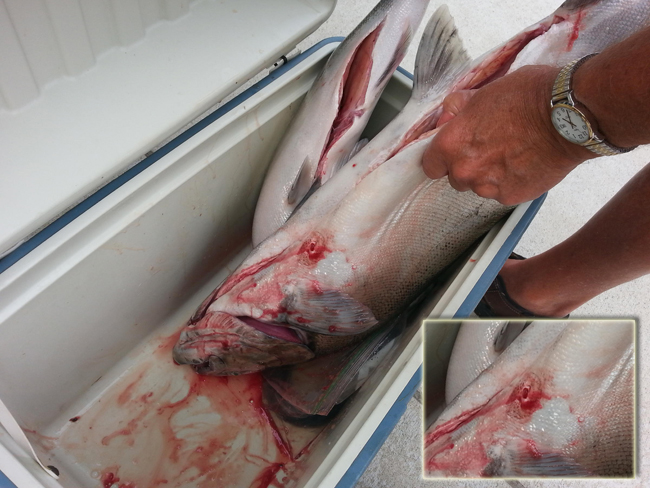 Fisherman Paul Zybczynski shows a lamprey wound on a fish he caught in Lake Ontario. Credit: Paul Zybczynski; Courtesy of WBFO
Fisherman Paul Zybczynski shows a lamprey wound on a fish he caught in Lake Ontario. Credit: Paul Zybczynski; Courtesy of WBFO
This audio clip is from a discussion on WBFO radio. Based in Buffalo NY, WBFO 88.3 FM is a part of the National Public Radio digital network. If you don't see the player above, it's because you're using a non-Flash device (eg, iPhone or iPad). You can download the mp3 file by clicking here (mp3). It may take a few minutes to download, so please be patient.
— By Angelica A. Morrison, WBFO FM
Buffalo, NY, October 24, 2017 - There’s some bad news in the Great Lakes and it’s all about the sea lamprey, an eel-like creature that literally sucks the life out of fish. They do a lot of damage and now they’re on the rise in some lakes.
That trend has stumped scientists.
A jar thuds on a table in Helen Domske’s office at the University at Buffalo. It’s a clear, large, one gallon container, just like the ones found in grocery stores, filled with crisp, green, dill pickles.
But, in this case it’s filled with a liquid solution, and a preserved gray corpse of a sea lamprey.
“They’re pretty gnarly looking," she says. "Here’s one you can see the teeth on it. It actually has teeth all over its mouth. And they’re pretty fierce. They really do a number.”
Domske is an educator for New York Sea Grant. She travels to schools and to public events to raise awareness about invasive species like the lamprey. She’s concerned about a new report from the Great Lakes Fishery Commission.
It says sea lamprey numbers have jumped in Lake Erie over the last three years. The trend is the same in Lake Superior, though their numbers are dropping in the other lakes.
Marc Gaden is with the fishery commission in Michigan and works with the lamprey control program.
“Lamprey is probably the worst of the invaders that have come into the great lakes, there’s no question about that,” he says.
Each adult can kill about 40 pound of fish in its lifetime. They burrow their tongues into fish and drain out blood. They especially hit lake trout.
Before lamprey control began in the 1950s, more than 100 million pounds of fish were lost in the Great Lakes every year. Now that’s dropped to about 10 million pounds.
So far, Gaden says, scientists haven’t pinpointed a reason for the uptick in Erie and Superior.
But, there are a few theories. One is that sea lampreys have more nesting sites — due to habitat restoration in the Lake Erie watershed.
“It’s kind of a two-edged sword. As we clean up the environment it makes it more hospitable,” Domske says. “Some of these creeks maybe didn’t have lamprey in them. But now as we really focus on water pollution and trying to control the pollution levels we’ve really created more habitat for them.”
Weather patterns could be a factor as well – affecting the way sea lamprey spawn.
“The other thing too, is the lamprey numbers went down significantly, after those two very cold winters 2014 and 2015, as you remember were really cold," she says. "And so the numbers may have gone down just because, in the spring the streams were so cold."
But the past two winters have been mild – leading to a better spawning season.
Gaden says there’s still more work to do, to keep the creature at bay.
“The problem with Lamprey is that they are resilient, they work very hard to spread their range they will find new habitat and infest it,” Gaden says. “There’s lots of fish in the lakes for them to eat and there’s nothing keeping them in check except for us.”
His group is working with the U.S. Fish and Wildlife Service to get the lamprey numbers back on target.
More Info: New York Sea Grant
New York Sea Grant (NYSG), a cooperative program of Cornell University
and the State University of New York (SUNY), is one of 33 university-based
programs under the National Oceanic and Atmospheric Administration’s
National Sea Grant College Program.
Since 1971, NYSG has represented a statewide network of integrated
research, education and extension services promoting coastal community
economic vitality, environmental sustainability and citizen awareness
and understanding about the State’s marine and Great Lakes resources.
Through NYSG’s efforts, the combined talents of university scientists
and extension specialists help develop and transfer science-based
information to many coastal user groups—businesses and industries,
federal, state and local government decision-makers and agency managers,
educators, the media and the interested public.
The program maintains Great Lakes offices at Cornell University, SUNY
Buffalo, SUNY Oswego and the Wayne County Cooperative Extension office
in Newark. In the State's marine waters, NYSG has offices at Stony Brook
University in Long Island, Brooklyn College and Cornell Cooperative
Extension in NYC and Kingston in the Hudson Valley.
For updates on Sea Grant activities: www.nyseagrant.org has RSS, Facebook, Twitter, and YouTube links. NYSG produces a monthly e-newsletter, "NOAA Sea Grant's Social Media Review," via its blog, www.nyseagrant.org/blog. Our program also offers a free e-list sign up via www.nyseagrant.org/nycoastlines for its flagship publication, NY Coastlines/Currents, which is published quarterly.